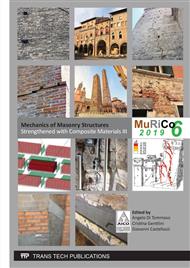[1]
Razavizadeh A, Ghiassi B, Oliveira D V. Bond behavior of SRG-strengthened masonry units: Testing and numerical modeling. Constr Build Mater 2014;64:387–97.
DOI: 10.1016/j.conbuildmat.2014.04.070
Google Scholar
[2]
Ghiassi B, Oliveira D V, Marques V, Soares E, Maljaee H. Multi-level characterization of steel reinforced mortars for strengthening of masonry structures. Mater Des 2016;110:903–13.
DOI: 10.1016/j.matdes.2016.08.034
Google Scholar
[3]
Lignola GP, Caggegi C, Ceroni F, De Santis S, Krajewski P, Lourenço PB, et al. Performance assessment of basalt FRCM for retrofit applications on masonry. Compos Part B Eng 2017;128:1–18.
DOI: 10.1016/j.compositesb.2017.05.003
Google Scholar
[4]
De Santis S, Carozzi FG, de Felice G, Poggi C. Test methods for Textile Reinforced Mortar systems. Compos Part B Eng 2017;127.
DOI: 10.1016/j.compositesb.2017.03.016
Google Scholar
[5]
Baena M, Torres L, Turon A, Llorens M, Barris C. Bond behaviour between recycled aggregate concrete and glass fibre reinforced polymer bars. Constr Build Mater 2016;106:449–60.
DOI: 10.1016/j.conbuildmat.2015.12.145
Google Scholar
[6]
Huang L, Chi Y, Xu L, Chen P, Zhang A. Local bond performance of rebar embedded in steel-polypropylene hybrid fiber reinforced concrete under monotonic and cyclic loading. Constr Build Mater 2016;103:77–92.
DOI: 10.1016/j.conbuildmat.2015.11.040
Google Scholar
[7]
Carozzi FG, Bellini A, D'Antino T, de Felice G, Focacci F, Hojdys Ł, et al. Experimental investigation of tensile and bond properties of Carbon-FRCM composites for strengthening masonry elements. Compos Part B Eng 2017;128.
DOI: 10.1016/j.compositesb.2017.06.018
Google Scholar
[8]
Naaman AE, Namur GG, Alwan JM, Najm HS. Fiber pullout and bond slip. ii: experimental validation. J Struct Eng 1991;117:2791–800.
DOI: 10.1061/(asce)0733-9445(1991)117:9(2791)
Google Scholar
[9]
Sueki S, Soranakom C, Mobasher B, Asce M, Peled A. Pullout-slip response of fabrics embedded in a cement paste matrix. J Mater Civ Eng 2007;19:718–28.
DOI: 10.1061/(asce)0899-1561(2007)19:9(718)
Google Scholar
[10]
Naaman AE, Namur GG, Alwan JM, Najm HS. Fiber pullout and bond slip. i: analytical study. J Struct Eng 1991;117:2769–90.
DOI: 10.1061/(asce)0733-9445(1991)117:9(2769)
Google Scholar
[11]
Banholzer B. Analytical simulation of pull-out tests- the direct problem. Cem Concr Compos 2005;27:93–101.
Google Scholar
[12]
Mobasher B. Mechanics of Fiber and Textile Reinforced Cement Composites. London- New York: Taylor & Francis Group; (2012).
Google Scholar
[13]
Dalalbashi A, Ghiassi B, Oliveira DV, Freitas A. Effect of test setup on the fiber-to-mortar pullout response in TRM composites: experimental and analytical modeling. Compos Part B Eng 2018;143:250–68.
DOI: 10.1016/j.compositesb.2018.02.010
Google Scholar


